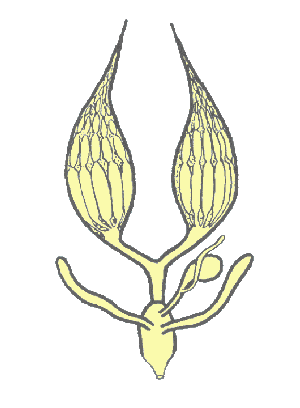Female Reproductive System
The female’s reproductive system contains a pair of ovaries. When the insect is actively reproducing, these organs swell with developing eggs and may nearly fill the abdomen. Each ovary is subdivided into functional units (called ovarioles) where the eggs are actually produced. A typical ovary may contain dozens of ovarioles, generally aligned parallel to one another. Near the distal end of each ovariole, there are a group of germ cells (oogonia) that divide by mitosis and increase in size to form oocytes. During active oogenesis, new oocytes are produced on a regular schedule within each ovariole. These oocytes migrate toward the basal end of the ovariole, pushed along by continued cell division of the oogonia. Each oocyte undergoes meiosis: this yields four cells — one egg and three polar bodies. The polar bodies may disintegrate or they may accompany the egg as nurse cells.
 As developing eggs move down the ovariole, they grow in size by absorbing yolk (supplied by adjacent nurse cells or accessory cells). Thus, each ovariole contains a linear series of eggs in progressive stages of maturation, giving the appearance of a “chain of beads” where each bead is larger than the one behind it. By the time an egg reaches the base (calyx) of the ovariole it has reached full size — often growing up to 100,000 times larger than the original oocyte.
As developing eggs move down the ovariole, they grow in size by absorbing yolk (supplied by adjacent nurse cells or accessory cells). Thus, each ovariole contains a linear series of eggs in progressive stages of maturation, giving the appearance of a “chain of beads” where each bead is larger than the one behind it. By the time an egg reaches the base (calyx) of the ovariole it has reached full size — often growing up to 100,000 times larger than the original oocyte.
Mature eggs leave the ovaries through short lateral oviducts. Near the midline of the body, these lateral oviducts join to form a common oviduct which opens into a genital chamber called the bursa copulatrix. Female accessory glands (one or more pairs) supply lubricants for the reproductive system and secrete a protein-rich egg shell (chorion) that surrounds the entire egg. These glands are usually connected by small ducts to the common oviduct or the bursa copulatrix.
During copulation, the male deposits his spermatophore in the bursa copulatrix. Peristaltic contractions force the spermatophore into the female’s spermatheca, a pouch-like chamber reserved for storage of sperm. A spermathecal gland produces enzymes (for digesting the protein coat of the spermatophore) and nutrients (for sustaining the sperm while they are in storage). Sperm may live in the spermatheca for weeks, months, or even years!
During ovulation, each egg passes across the opening to the spermatheca and stimulates release of a few sperm onto the egg’s surface. These sperm swim through the micropyle (a special opening in the egg shell) and get inside the egg. Fertilization occurs as soon as one sperm’s nucleus fuses with the egg cell’s nucleus. Oviposition (egg laying) usually follows closely after fertilization. Once these processes are complete, the egg is ready to begin embryonic development.

